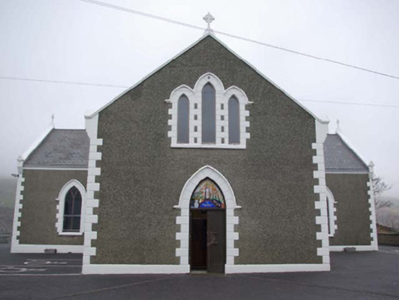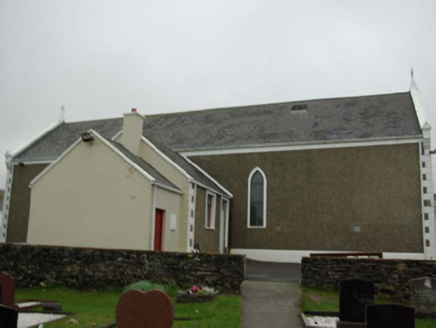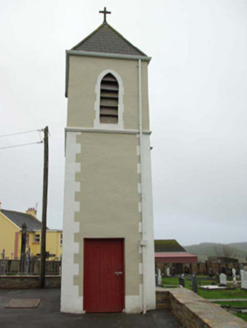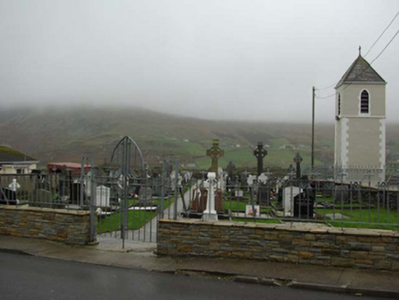Survey Data
Reg No
40841003
Rating
Regional
Categories of Special Interest
Architectural, Social
Previous Name
Gleann Cholm Cille Catholic Parish Church
Original Use
Church/chapel
In Use As
Church/chapel
Date
1830 - 1860
Coordinates
153226, 384616
Date Recorded
14/11/2007
Date Updated
--/--/--
Description
Freestanding double-height Catholic church on T-shaped plan, built in 1833 or 1854 and altered 1904, having single-bay hall to the south/south-west, single-bay transepts to the east and west, and with two-bay single-storey sacristy to the centre of the rear elevation (north) having later single-bay extension attached to the north gable end. Pitched artificial slate roofs having raised rendered verges to gable ends with Celtic cross finials to gable apexes and moulded kneeler stones at eaves level having gabled finials over. Pebbledashed walls over smooth rendered plinth course, rendered band to eaves, and render block and start quoins to the corners. Pointed-arched window openings having raised render block- and-start surrounds, hoodmouldings and timber Y-tracery windows. Three graded pointed-arched window openings to entrance gable (south), over main doorway, having raised render block- and-start surrounds, hoodmouldings, and plain windows. Two pointed-arched window openings to rear elevation having plain rendered surrounds and stained glass windows. Pointed-arched door opening to the centre of entrance gable (south) having raised render block- and-start surrounds, hoodmoulding, replacement timber double-doors, and modern mosaic overpanel. Crown post timber roof to interior; modern timber organ gallery over entrance gable (south). Square-headed openings to sacristy and attached extension having modern fittings. Set slightly back from road in own grounds with tarmacadam carpark to site. Graveyard to the west having collection of mainly twentieth-century gravemarkers and memorials. Freestanding three-storey belltower (on square-plan), c. 1900, to north-west having pyramidal slate roof with cross finial, rendered walls, pointed-arched openings at belfry level having timber louvers, and square-headed doorway with timber door.
Appraisal
This simple early-to-mid nineteenth-century Catholic church retains its early form, and much of its early character, despite some alteration and additions in recent years. The pointed -arch openings give it the bare minimum Gothic character. Its simple form and relative lack of ornament is typical of early post-Emancipation (1829) Catholic churches in Ireland and the plain elevations are almost vernacular in character. The surrounds to the openings add a hint of decoration to this otherwise plain edifice. The altered interior is notable for the open crown-post timber roof structure and the figurative stained glass windows to the north wall. The present church may have been originally built as a hall-type Catholic church in 1833 (indicated on Ordnance Survey first edition six-inch map of 1837; Slater’s Directory of 1894 records that it was built in this year). It was apparently rebuilt or heavily remodelled in 1854. The church was remodelled in 1904 to designs by the architectural firm Doolan, Butler and Donnelly, who also designed the new Catholic church at nearby Cill Charta/ Kilcar (see 40844010) around the same time (1903 – 04). The nature of these works are not known but may have included the installation of the stained glass windows and the construction of the freestanding belltower, and possibly the construction of the sacristy. The present belltower replaced an earlier one at or close to the present site. This was a modest single-storey rendered block surmounted with an open bell and mechanism (Lawrence photograph c. 1900). Although altered, this simple church is an integral element of the social history and built heritage of Gleann Cholm Cille/Glencolumbkille, and is a landmark feature in the centre of the village making a strong contribution to the streetscape. The graveyard to site adds to the context of this building, and completes the setting. This graveyard contains mainly twentieth century gravemarkers (from 1899).



















